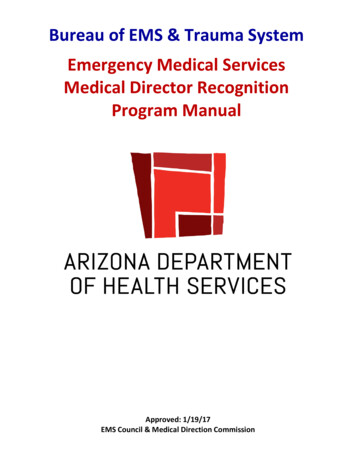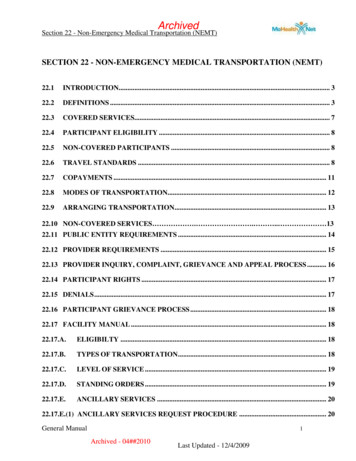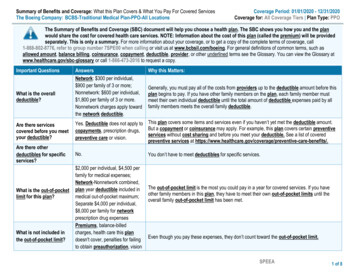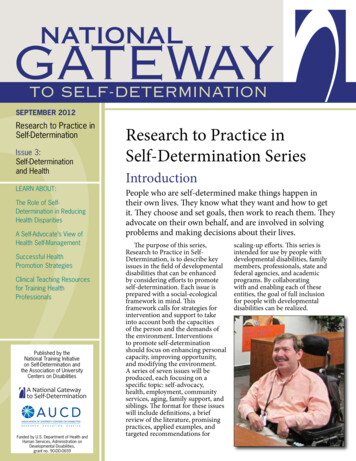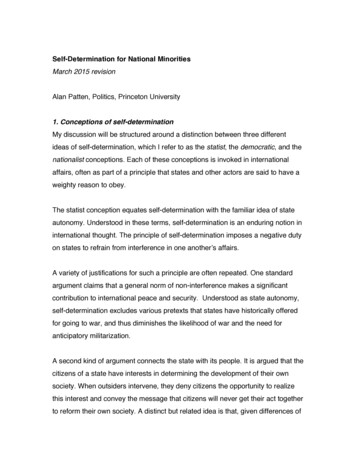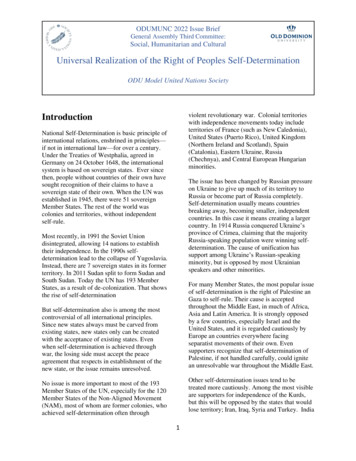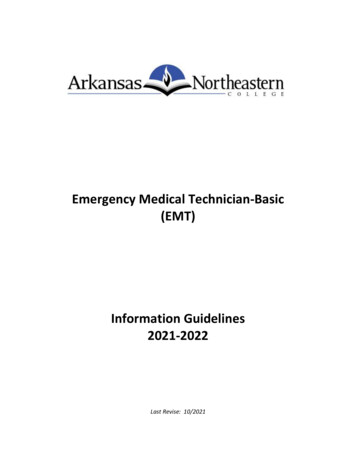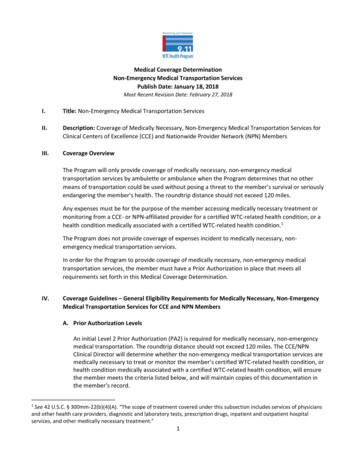
Transcription
Medical Coverage DeterminationNon-Emergency Medical Transportation ServicesPublish Date: January 18, 2018Most Recent Revision Date: February 27, 2018I.Title: Non-Emergency Medical Transportation ServicesII.Description: Coverage of Medically Necessary, Non-Emergency Medical Transportation Services forClinical Centers of Excellence (CCE) and Nationwide Provider Network (NPN) MembersIII.Coverage OverviewThe Program will only provide coverage of medically necessary, non-emergency medicaltransportation services by ambulette or ambulance when the Program determines that no othermeans of transportation could be used without posing a threat to the member’s survival or seriouslyendangering the member’s health. The roundtrip distance should not exceed 120 miles.Any expenses must be for the purpose of the member accessing medically necessary treatment ormonitoring from a CCE- or NPN-affiliated provider for a certified WTC-related health condition, or ahealth condition medically associated with a certified WTC-related health condition.1The Program does not provide coverage of expenses incident to medically necessary, nonemergency medical transportation services.In order for the Program to provide coverage of medically necessary, non-emergency medicaltransportation services, the member must have a Prior Authorization in place that meets allrequirements set forth in this Medical Coverage Determination.IV.Coverage Guidelines – General Eligibility Requirements for Medically Necessary, Non-EmergencyMedical Transportation Services for CCE and NPN MembersA. Prior Authorization LevelsAn initial Level 2 Prior Authorization (PA2) is required for medically necessary, non-emergencymedical transportation. The roundtrip distance should not exceed 120 miles. The CCE/NPNClinical Director will determine whether the non-emergency medical transportation services aremedically necessary to treat or monitor the member’s certified WTC-related health condition, orhealth condition medically associated with a certified WTC-related health condition, will ensurethe member meets the criteria listed below, and will maintain copies of this documentation inthe member’s record.1See 42 U.S.C. § 300mm-22(b)(4)(A). “The scope of treatment covered under this subsection includes services of physiciansand other health care providers, diagnostic and laboratory tests, prescription drugs, inpatient and outpatient hospitalservices, and other medically necessary treatment.”1
Where a Level 3 Prior Authorization (PA3) is required, the WTC Health Program will review themedical justification provided by the CCE/NPN Clinical Director and determine whether the nonemergency medical transportation services exceeding the Level 2 threshold are medicallynecessary to treat or monitor the member’s certified WTC-related health condition, or healthcondition medically associated with a certified WTC-related health condition. The WTC HealthProgram will also ensure that the member meets the criteria listed below.For detailed Prior Authorization procedures, see instructions found in the WTC Health Program’sAdministrative Manual.2B. Prior Authorization CriteriaThe WTC Health Program will provide coverage of up to two roundtrips, each of which shouldnot exceed 120 miles, in a 30-calendar day period for non-emergency medical transportationservices in an ambulette or ambulance with a Level 2 Prior Authorization (PA2).3 Once thisthreshold of two roundtrips in a 30-calendar day period is met, or if a roundtrip distanceexceeds 120 miles, a Level 3 Prior Authorization (PA3) is required for subsequent trips or excessmiles. For each roundtrip, whether a PA2 or a PA3, the member must continue to have amedical condition which prevents them from utilizing any transportation other than nonemergency medical transport in an ambulette or ambulance. See “subsequent authorizationcriteria” below.The WTC Health Program will provide coverage of non-emergency medical transportationservices by either ambulette or ambulance carrier. A PA2 (CCE/NPN Clinical Director review) isrequired for non-emergency medical transportation services for each type of carrier. The PriorAuthorization must provide documentation of why the choice of carrier, ambulette orambulance, is medically necessary. Up to two roundtrips in a 30-calendar day period, each ofwhich should not exceed 120 miles, may be requested in a single PA2 Request. All ambuletteand ambulance PA2 Requests will be audited by the WTC Health Program within six (6) monthsof reimbursement.1. Specific Prior Authorization CriteriaPA2 or PA3 Requests for non-emergency medical transportation services in an ambulette orambulance must include a strong narrative regarding the member’s risk of a medicalemergency, and document evidence of each of the following requirements (a. through f.):a. The member has a certified WTC-related health condition or health condition medicallyassociated with a certified WTC-related health condition. The health condition triggeringthe need for non-emergency medical transportation services, however, may be eitherthe certified WTC-related health condition, the certified health condition medicallyassociated with a certified WTC-related health condition, or another health condition inaddition to the certified health condition.2WTC Health Program Administrative Manual, [Chapter 4, Section 11], at https://www.cdc.gov/wtc/ppm.html.See generally overage-of-Ambulance-Services.pdf. The WTCHealth Program has elected to establish Program-specific criteria and thresholds.32
b. The member has no other means of transportation available through publictransportation, city or state public service assistance agencies, or known acquaintances.c. The non-emergency medical transportation is determined to be medically necessarybecause at least one of the following criteria is established:1) The member is wheelchair bound or has a disabling physical condition that requiresthe use of a walker or crutches and is unable4 to use a taxi, livery service, bus, train,or private vehicle (e.g., due to the use of a non-collapsible wheelchair or otherwiserequiring a specially configured vehicle);2) The member requires radiation therapy, chemotherapy, or dialysis treatments thatresult in a disabling physical condition, making the member unable to accesstransportation without the personal assistance provided by non-emergency medicaltransportation personnel;3) The member has a severe debilitating weakness or a disabling physical condition,other than any condition described above, requiring the personal assistanceprovided by non-emergency medical transportation personnel; and the orderingprovider certifies and provides in narrative that the member cannot be transportedby taxi, livery service, bus, or private vehicle as a result;4) The member is mentally disoriented as a result of medical treatment, or has amental impairment or a disabling mental condition, and requires the personalassistance of non-emergency medical transportation personnel; and the orderingprovider certifies and provides in narrative that the member cannot be transportedby a taxi, livery service, bus, or private vehicle as a result (e.g., member isdisoriented to person/place/time; acute severity hallucination;delusions/inappropriate in public situations; threat/suicidal/homicidal with a plan;acute psychotic symptomatic manic episode; chemical dependency – acutewithdrawal or acute intoxication);5) The member has a functional orthopedic impairment precluding unassistedambulation (bilateral or unilateral amputee, lower extremities; cast on lowerextremity or half body; fracture of pelvis, hip, femur or leg; severe arthritis oflocomotor joint);6) The member has a neuromuscular impairment precluding unassisted ambulation(spinal injury);7) The member has suffered a cerebrovascular accident with resultant hemiplegia orhemiparesis (stroke);8) The member has peripheral vascular disease precluding unassisted ambulation(severe claudication; foot ulceration);4“Inability to use” implies that a member has a medical condition prohibiting him/her from having the physical capability touse a taxi, livery service, bus, or private vehicle.3
9) The member has severe respiratory disease (emphysema; chronic obstructivepulmonary disease; and chronic bronchitis) or cardiac disease necessitating physicalassistance on stairs;OR10) The member has some other physically disabling health condition or treatmentpreventing the member from being transported by a taxi, livery service, bus, orprivate vehicle (must be provided in narrative by the ordering provider).5d. The member is assigned to a CCE- or NPN-affiliated physician or provider and thetransportation is being provided to receive treatment or monitoring services to manage,ameliorate, or cure a currently certified WTC-related condition or health conditionmedically associated to a WTC-related health condition;e. The transportation provider is enrolled in the WTC Health Program provider network,contracted with the associated NPN provider, or is classified as a CMS provider and thetransportation provider agrees to accept WTC Health Program reimbursement rates aspayment in full;f.The vehicle providing services to the member is traveling directly to or from one of thebelow listed locations:1) Member’s home6 to CCE/NPN or affiliated office or facility;2) CCE/NPN or affiliated office or facility to member’s home;3) Discharge to member’s home from a facility providing acute care services;4) Discharge to member’s home from facility providing post-acute care services;OR5) Transfer from one CCE/NPN or affiliated office or facility to another CCE/NPN oraffiliated office or facility.2. Subsequent AuthorizationsIf more than two roundtrips in a 30-calendar day period are needed, or if a roundtrip willexceed 120 miles, and if the member still has a medical condition which prevents anytransportation other than non-emergency medical transportation in an ambulette orambulance, then the Prior Authorization will change from a Level 2 to a Level 3 for the thirdroundtrip or excess miles and any subsequent roundtrips within the 30-calendar day period.PA3 Requests may list multiple upcoming appointments requiring medically-necessarytransportation. PA3 Requests must be submitted to the Program by the CCE/NPN Clinical5Situations in which the CCE or NPN Clinical Director chooses to provide evidence of “other physically disabling healthconditions or treatments preventing the member from being transported by a taxi, livery service, bus, or private vehicle,”must be well-documented by the CCE/NPN Clinical Director and may be considered by the Program on a case-by-case basis.6The member’s home is defined as any residence in which the member is/will be residing.4
Director and should list all of the authorization criteria specified above and explain why themember requires more than two roundtrips in a 30-calendar day period or why the memberrequires a roundtrip in excess of 120 miles. When a new 30-calendar day period begins, thefirst two roundtrips in the new period may once again be reviewed at a Level 2 PriorAuthorization.V.Prior Authorization Request Submission RequirementsLevel 2 Prior Authorization (PA2) Requests for Non-Emergency Medical Transportation Services mustbe submitted to the CCE/NPN Clinical Director or Designee; the CCE/NPN Clinical Director orDesignee will decide whether to authorize the service and document that decision and the requiredcriteria in the member’s record. All PA2 Requests for non-emergency medical transportationservices in an ambulette or ambulance will be audited within six (6) months of reimbursement.Level 3 Prior Authorization (PA3) Requests for Non-Emergency Medical Transportation Services mustbe signed by the requesting CCE/NPN Clinical Director or Designee and submitted to Karna throughthe SFTP server. Incomplete requests will be returned to the requesting CCE/NPN for additionalinformation. The WTC Health Program will decide whether to authorize the service and inform theCCE/NPN. The CCE/NPN will document the request, all required criteria, and the decision in themember’s record.All documentation for completed non-emergency medical transportation service authorizationrequests are subject to audit by the WTC Health Program.VI.Billing/Coding GuidelinesAll applicable codes are listed in the WTC Health Program codebook, located on the Secure AccessManagement services (SAMs) portal.A. Non-emergency medical transportation code ranges 961For consideration of codes that are not currently existing in the WTC Health Program codebook,please submit a WTC-5 Medical Code Request form via the standard WTCMedCode@csra.commailbox process.VII.Revision HistoryA. Code ranges removed and specific applicable codes listed, as currently listed in the WTC HealthProgram codebook. Language added to section V. January 29, 20185
B. “Exceed 120 miles” language revised throughout. Revised language in reference to the Level 2and Level 3 Prior Authorization Requests throughout. Added “monitoring” language throughout.February 27, 20186
transportation without the personal assistance provided by non-emergency medical transportation personnel; 3) The member has a severe debilitating weakness or a disabling physical condition, other than any condition described above, requiring the personal assistance provided by non-emergency medical transportation personnel; and the ordering

